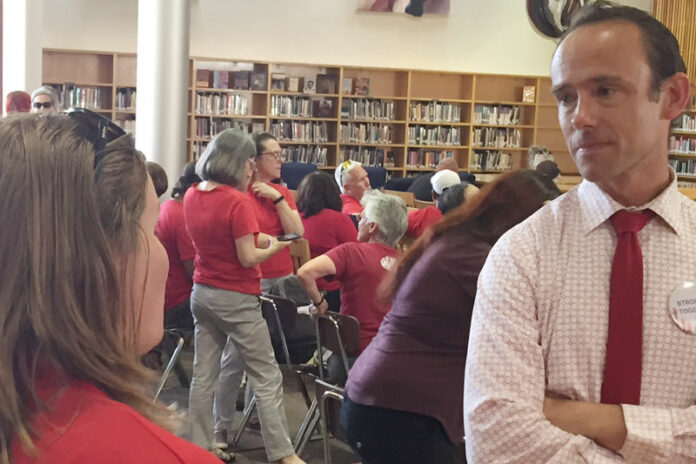UPDATE: After the paper went to press, union negotiator Brian Miller confirmed that, after meeting with the district during the day on Wednesday, Nov. 6, the union is planning to go on strike next Wednesday, Nov. 13.
The West Sonoma County Union High School District and its union, the West Sonoma County Teachers Association, are at the end of a long negotiating process.
They’ve been negotiating — and locking horns — since November 2018, and the teachers have been working without a contract for a year now.
In April, both sides told the Public Employee Relations Board (PERB) that they were at an impasse, and over the last several months, they’ve been going through PERB’s facilitated negotiation process. They have just finished the final step of this process: fact-finding.
Unable to come to an agreement in negotiations, they laid their case before a fact-finding panel on Oct. 7, and the neutral fact-finding report was released on Oct. 25.
Any hope that the fact-finder would come up with a solution agreeable to both sides vaporized when readers of the report learned that the fact-finder had actually laid out two recommendations: a main recommendation and an alternative.
As might have been expected, the teachers seized on the first recommendation — a 12% raise over three years — while the district seized on the alternative proposal — a 4% raise over one year. And both groups found something to disagree with in the alternatives they chose.
Recommendation No. 1: 12% raise over three years
The neutral fact finder found the union’s case for the hardship posed for teachers living in a high cost of living area convincing.
The fact-finder reported that “While the district asserted that its budgetary obligations prevent it from offering higher salary increases to their teachers, the local economic climate is not sustainable for their teachers due to the ratio between their salaries and housing costs. The district’s teacher salaries make it difficult for them to buy or rent a home in the district where they work … The neutral fact-finder panel chair finds that the teachers’ salaries are too low, and a competitive salary increase is necessary.”
To address this issue, the neutral fact-finder recommended the following: “A regional average salary increase of 4% per year for a three-year contract: 2% July 1, and 2% Jan. 1 in fiscal years 2018-19, 2019-20, and 2020-21.”
She recommended that “retroactive payments shall be made for 2018-19 and 2019-20.”
Other features of her recommendation included a compromise that would slightly lower the benefits package, recommending “an employer-capped contribution to health insurance premiums equal to the family premium of a health maintenance organization plan and employer-paid vision and dental insurance.”
Because the district offers one of the most expensive benefit plans in the region, the neutral fact-finder suggested that “the district and union shall establish a committee to compare the current cost of health insurance with CalPERS plans,” as well as opt-out options for the current health plan.
The recommendation also suggested cuts to retirement benefits, suggesting that “only unit members hired prior to this date shall continue to receive district health benefits upon retirement.” Instead, the neutral fact finder recommended that retirees “under the age of 55 shall receive the district’s benefits for a maximum of three years, and retirees 55 and over shall receive the district’s health benefits for a maximum of six years.”
Even under the 12% plan, the union wasn’t happy with the decrease in health care and retirement benefits.
“We don’t agree with the health care switch. We believe we should be investigating saving money by taking a look at CalPERS,” said Brian Miller, a math teacher at Analy and the union’s chief negotiator, referring to the California Public Employees’ Retirement System health insurance plans. “CalPERS’ rate actually went down last year.”
Regarding the cut to health insurance benefits for retirees, he said, “We also don’t want two classes of employees— we don’t want to split the union like that.”
Alternative: 1-year contract with a 4% retroactive raise
As an alternative, the neutral fact-finder suggested that the district give the teachers a one-year contract with a 4% retroactive increase for the 2018-19 school year. Health and retirement benefits would stay the same as they are now.
In his opinion statement on the fact-finders report, the district’s attorney Paul Boylan wrote that the district concurred with this alternative recommendation.
He rejected outright the option of raising teacher salaries 12% over three years.
“The district has demonstrated time and again that it cannot afford the increases proposed by the association, and doing so will force the district to have a qualified, and possibly negative budget certification, requiring additional oversight from the Sonoma County Office of Education and extreme cost reductions … Given the district’s current funding levels, ongoing declining enrollment and significant reductions the district has already enacted, the chair’s recommendations are not in the best interest of the district, as the district attempts to balance an ongoing deficit with the interest and welfare of the students it serves.”
Miller said he wouldn’t even bring the one-year option to his membership.
“As far as we’re concerned the only recommendation that is worth discussing is the three-year at 12%,” he said. “The other one — we’ve never had a one-year deal on the table — so it just seems absurd. Twelve percent is what we’ve been asking for all along.”
“This is about prioritizing teachers in the budget and so to do this one-year deal on a year whose books are already closed, so it doesn’t attain our goal of having teachers be a top priority in the budgeting process. No teacher wants to go right back to bargaining; the members don’t want that,” he said.
Boylan had a different take on the one-year offer.
“This fact-finding report is a heroic effort to persuade the parties to continue talking,” he said, noting that it could be seen as an opportunity to start negotiations afresh — with a 4% retroactive raise in place for teachers — and, in new negotiations, the potential for more raises to come.
What now?
Miller declined to say if or when the union planned to strike.
“A strike is not what the teachers would like to do so if we could come to a tentative agreement before that, that would be ideal,” he said, noting that the success of those negotiations would depend on the district being “serious.”
“We don’t want another offer of 0% and 3% for two years,” he said.
In the meantime, Boylan said the district is looking for every possible way to free up more money for the teachers.
“They are involved in the most creative thinking I’ve ever seen in any district to try to come up with more,” Boylan said, “but at the same time without sacrificing educational programs or district excellence.
“They want to avert a strike if at all possible,” Boylan said. “Everyone does because a strike is destructive. Ultimately, it harms the district’s finances, and ultimately it fractures the community. We want to avoid that if we can, and we’re working hard to do so.”
For his part, Miller said he hoped the fact-finders report had changed some minds on the school board.
“I hope that now that the fact-finder has clearly sided with the union — I mean it’s not perfect for us, but it’s much closer to what we were saying than what the district was saying — I hope that frees the board up and gives them a way out. They can say ‘OK, this is what the fact-finder recommended’ … I would hope this nudges them to do the right thing and pay their teachers.”
But he’s not holding his breath.
“We need public support,” he said. “People need to email the board and show up to the board meeting to support the teachers.”









